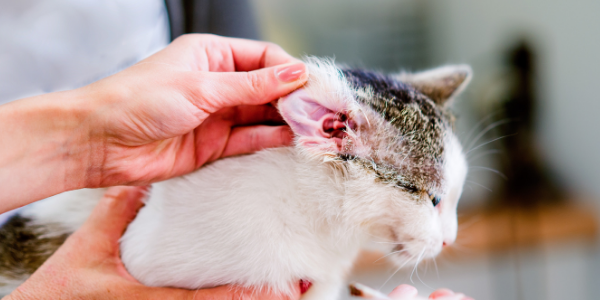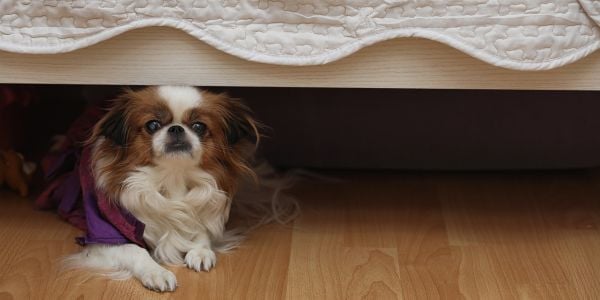 One thing I have always tried to make sure of is that my clients know how and when to clean their pet’s ears.
One thing I have always tried to make sure of is that my clients know how and when to clean their pet’s ears.
Knowing how and when helps lessen the frequency of ear infections. BUT it is also important to know when NOT to clean your pet’s ears; we are here to help you with that.
Lots of cats and dogs get itchy, dirty ears. It's sometimes safe to clean their ears at home, but not always. Not every “itchy ear” episode is the same, and you could do more harm than good.
Diving right in with cleaner or medication — even one that your vet previously prescribed — can cause problems.
When to Definitely NOT Clean Your Pet's Ears
If you notice any of the following symptoms, please hold off on putting anything into your pet’s ears until your veterinarian has had a chance to evaluate them:
- Earflap is red and warm to the touch
- Earflap is puffy or swollen
- Frequently shaking their head
- Scratching, digging, or rubbing the ears frequently
- Crusting or scabs around the ear or on the pinna (earflap)
- Abnormal discharge coming from the ear(s) – this can be brownish or cream in color
- Ear canal is narrowed (called “stenotic”) compared to what it normally looks like
- Hot spot present in the region of the ear
- Strange odor coming from the ear(s)
- Hearing loss
- Head tilted to one side, walking like they’re drunk (called ataxia), or walking in circles
- Your pet is “guarding” their ears — often shown by turning or moving their head away as you try to pet them, sometimes exhibited by them growling, hissing, yelping, or trying to bite your hand when you put it near their painful ear
Only your vet can look down in your pet’s ear canals, properly diagnose the problem (and any potential underlying problem that keeps chronic infections coming back), and prescribe the most effective and safest treatment plan.
If their treatment plan does include at-home cleanings, check out our step-by-step guide on how to clean your pet’s ears.
Other Reasons You Should Not Clean Your Pet's Ears
It Could Be an Ineffective Ear Cleaner or Medication
In the best-case scenario, if your pet has a bacterial infection in their ear and you use a cleaner or medication that works best against a different problem, like a yeast infection, you’re not likely to fix the problem; you could make it worse – by creating an environment that’s even more favorable to bacterial growth – and you may be prolonging your pet’s discomfort.
Note: Just as the wrong cleaner can cause an issue, over-cleaning with a good ear cleaner isn’t good either. Cleaning TOO often can cause irritation and possibly damage to the ear canal, which can result in an ear infection.
Using An Inappropriate Technique
Most of us have heard the saying, “Do not put anything smaller than your elbow in your ear!”. Well, that applies to your pet’s ears as well. As tempting as it may be to swab their ear with a Q-tip® or wipe, you can actually cause (or worsen) an infection. Q-Tips, wipes, and even your finger can cause damage to the thin and delicate lining of the ear canal, which allows for opportunistic yeast and bacteria to cause an infection.
Besides causing an infection, Q-Tips or any other object stuck in the ear canal can cause wax to be pushed down deeper, making it harder to remove and potentially blocking moisture. Using an appropriate ear cleaner and flushing out the gunk will help clean out ears versus using a cotton swap or wipe, but it's best to leave a deep clean to veterinary professionals.

A Ruptured Ear Drum
On the other end of the spectrum, if your pet’s eardrum is ruptured, which can easily happen with long-standing ear infections, or in the presence of a foreign body, like a foxtail or a tumor/polyp — the medication or cleaner you put into your pet’s ear(s) could cause deafness and much more severe pain.
Note: If your pet shows any symptoms of a ruptured eardrum, they should be promptly taken to a veterinarian.
Symptoms of a ruptured ear drum in a dog or cat
- Sudden hearing loss
- Painful acting around their ears
- Discharge from the ears
- Shaking their head
- Tilting their head
- Eyes shifting back and forth (nystagmus)
- Paralysis to the face, which includes the inability to blink
The Ear Cleaner Could Sting
Most often, what happens is that a cleaner containing rubbing alcohol, hydrogen peroxide, or witch hazel is put into an already red and painful ear, causing burning and much more severe discomfort for your pet. This can cause your pet to develop fear and anxiety associated with ear handling. We vets see the result of this on a daily basis in hospitals across the country.

Behavior Issues
When it comes to ear handling, some pets can be aggressive due to fear or anxiety. This can make ear cleaning and treatment nearly impossible. Never risk their or your safety in an attempt to clean their ears.
If you know your pet has ear handling issues and they develop an ear infection, consult with your veterinarian if a long-acting ear medication or one that does not require cleaning during the treatment process is available for your pet’s type of infection. Also, discuss with your veterinarian about medications to ease any pain and calm them so that treatment can be done.
Training your pet to wear a basket muzzle will be helpful to avoid being bitten when ear cleaning or treatments are needed.
Consult with a certified canine or feline behavior consultant about how to desensitize and counter-condition your pet to change their emotions about ear handling. These protocols should not be done while your pet has an active infection since they are already in discomfort and pain.
Note: When attempting to clean your pet’s ears, wait until they are calm and sleepy. Attempting to clean their ears while they are excited or energized will not only frustrate you, but it can result in an infective cleaning and possible trauma to the ear canal.




